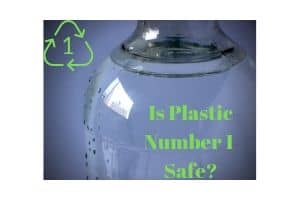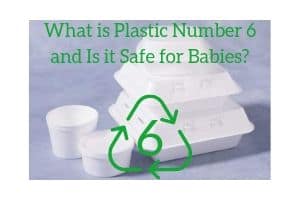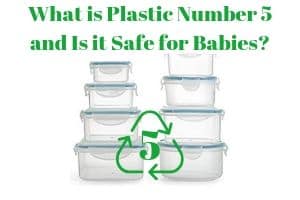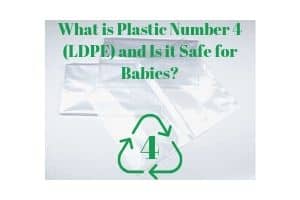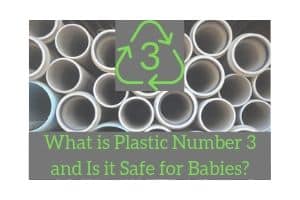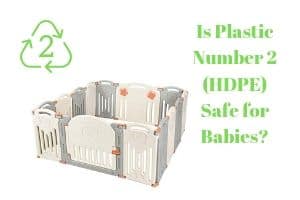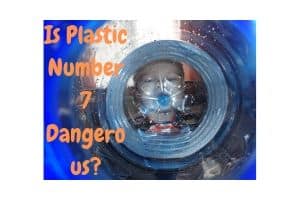Avoiding plastics these days is nearly impossible but many parents probably find themselves wondering which plastics, if any, are safe for their babies. Because there are so many different types, I decided to break them all down in a little plastics mini-series. Today, we’ll find out what plastic number 1 is and if we should worry about it.
Plastic Number 1 (PETE or PET) is commonly used to make products such as water, soda, or condiment bottles. While normally labeled safe, PETE can still leach antimony and estrogenic chemicals into its contents, especially when heated.
The more I read about it, the more I’ve grown to hate plastics for the potential dangers they can pose to myself and my family. It’s crazy to me that companies could put food and water into materials that leach dangerous chemicals, but sadly that’s the world we live in today. Let’s dive into the details for this particular plastic.
Table of Contents
What is plastic number 1?
There are many different kinds of plastics used in consumer products today and if you look on the bottom there will probably be a number between 1 and 7 along with a few symbols. These numbers are resin identification codes that are meant to help recyclers distinguish between different plastic compounds, but they are also useful for consumers to determine what they are dealing with.
If your plastic has the number “1” on the bottom then it is made of polyethylene terephthalate (PETE or PET). It is one of the most important and valuable man-made fibers on earth in terms of weight produced each year. There is also more PETE recycled than any other type of plastic, although some estimates say that only a quarter of what is produced each year is actually recycled.
Number 1 plastic examples
PETE can be found in a huge amount of products on the market today. The most familiar example is plastic water or soda bottles, but you’ll also find it used in clothing, carpets, film, furniture, and others.
For baby products, you are most likely to find plastic number 1 in food containers, clothing fabrics, or the outer liner on your diapers.
How could plastic number 1 be dangerous for babies?
As with most plastics, the potential danger is that it could leach out chemicals from the plastic into the water or food contained inside. There have been many reports over the years of plastics doing exactly that and there isn’t as much transparency as you might think around this testing.
Does plastic number 1 contain BPA?
Fortunately, you won’t have to worry about BPA in your PETE bottles or other items because it isn’t normally used in the manufacturing process. BPA is a chemical that is still used in many plastics to make them harder and shinier. Studies have linked it to issues with human fertility, puberty, and some cancers.
Antimony will leach from plastic 1 over time
With number one plastic, studies have shown that the most likely chemical to leach into food and water is antimony as it is used in the production process. While antimony is a naturally occurring metalloid, it can be found in PETE bottles at levels as much as 100 times that of normal groundwater. At high levels, antimony can produce toxic effects such as diarrhea, vomiting, or stomach ulcers.
To reduce the amount of antimony in your water, keep it cool. Further research has shown that exposing these bottles to heat can significantly increase the leaching rate and it will continue to build up over time. For reference, your car could easily heat up to the 150 degrees cited in this research so avoid drinking water that has been left outside and try to store your bottles in a cool, dark place before you use them!
Don’t reuse plastic number 1
Another issue with PET bottles and containers is that this particular type of plastic is rather porous. This is an issue because porous materials make it easy for things like bacteria, flavors, scents, and dyes to get trapped inside the material. As you can imagine, this makes it difficult to clean this kind of plastic and it is recommended that you don’t reuse it.
I have to admit that I have frequently found myself reusing plastic water bottles because I hate using them in general and I always try to get multiple uses out of them before they get recycled to try and ‘do my part’ at reducing plastic usage. A better way to reduce the usage would just be to avoid buying the bottles!
Number 1 plastic should be recycled
Fortunately, it’s extremely easy to recycle PETE bottles and containers and they will be accepted at nearly every recycling center or curbside pickup. They will crush and shred the material into small flakes which will be reprocessed to make new bottles or even spun polyester fibers for use in furniture or clothing. About 25 percent of PET water bottles are recycled today in the US.
Safe alternatives to number one plastic
Although this type of plastic is considered relatively safe, it probably still a good idea to avoid it if possible due to the potential issues with antimony and some estrogenic chemicals leaching into your food or water. Also, don’t forget that even if you are careful with the storage of your bottles, they have been around for a long time before you got your hands on them. They could have been sitting in a hot warehouse for months before they even made it to the store you purchased them from, providing ample opportunity for leaching.
The safest plastic for use in baby products
If you want to hang on to plastic containers for your baby products, either because of cost or convenience, then you should at least try to look for some that use plastic number 5. That type of plastic, polypropylene, is considered the safest and most stable plastic for food and beverage containers. Most bottles and other baby items will likely be made of this plastic anyway, but always check to be sure.
Avoiding plastic altogether
Of course, getting rid of plastic completely is another solid option. You won’t have to worry about the possibility of chemical contamination and you’ll be able to reuse the containers many times which can save lots of money in the long term. This is doubly true if you are able to use the alternatives for multiple babies over the years!
When it comes to plastic alternatives, stainless steel is a great option. If you want to pick up a fantastic starter set for your baby then I highly recommend the Pura Stainless kit. It includes two stainless steel baby bottles along with interchangeable silicone slow flow nipples, medium flow nipples, sipper spouts, travel covers, and sealing discs. There’s two of everything! Check out the latest reviews and purchase it here on Amazon.
Learn about the other plastic numbers
We’ve covered plastic number 1 pretty well today, but be sure to check out my deep dive into plastic number 2 (HDPE). It’s an interesting one that you probably didn’t know was all around you!

